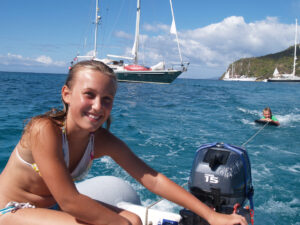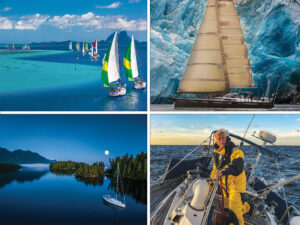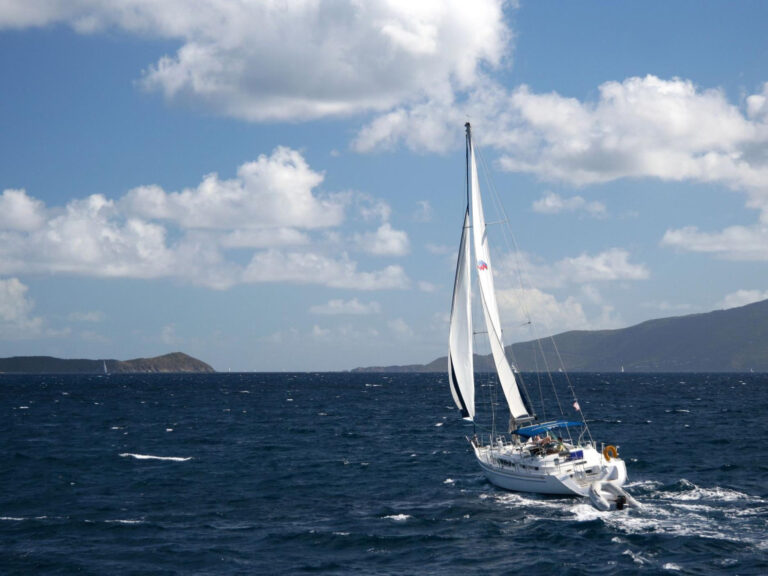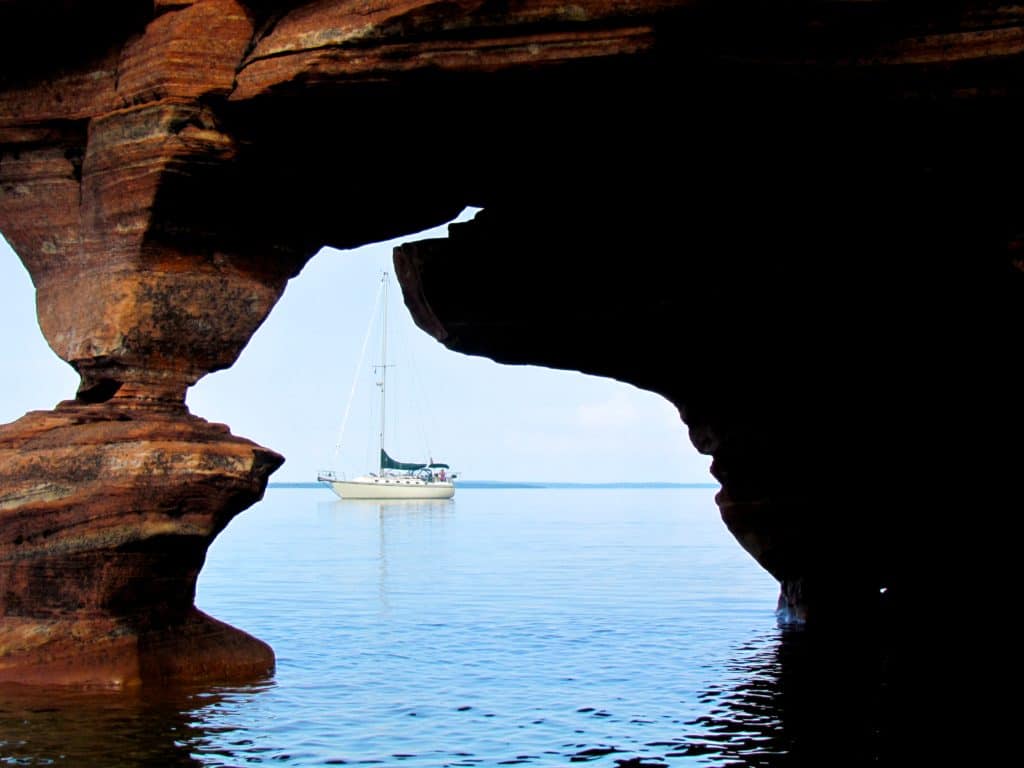
It was a noise unlike any we had ever heard on our boat. It was well after midnight, and the sound was like a classroom of schoolchildren madly scraping their fingernails on a blackboard. Instantly we were awake, and we realized our boat was moving hard to port. Then our motion stopped with a massive thunk.
Clouds obscured the quarter-moon as we staggered to the cockpit. We were clearly still floating, and we could see we were pretty much where we had anchored the evening before, but there were now two-foot waves smacking our bow.
Welcome back to the Apostle Islands, we said to each other. Clearly we had not learned our lesson from our previous visit. Even worse, we wondered why we had bothered to come back at all.
My wife, Jennifer, and I sail our Caliber 38, Catamount, out of northern Michigan and spend our summers on Lake Superior. We had been to the Apostles once before, and frankly, we were not impressed. The islands are touted as one of the premier cruising grounds in the country, with reliable winds and accessible wilderness in the Apostle Islands National Lakeshore. But we had found lots of crowds and mostly round islands with virtually no protection. Swells rocked us mercilessly all night, every night. Midnight wind shifts resulted in a mess of boats hauling anchor and moving to the other side of the island or the lee of an island nearby, neither of which was really any better. We vowed we would never come back.
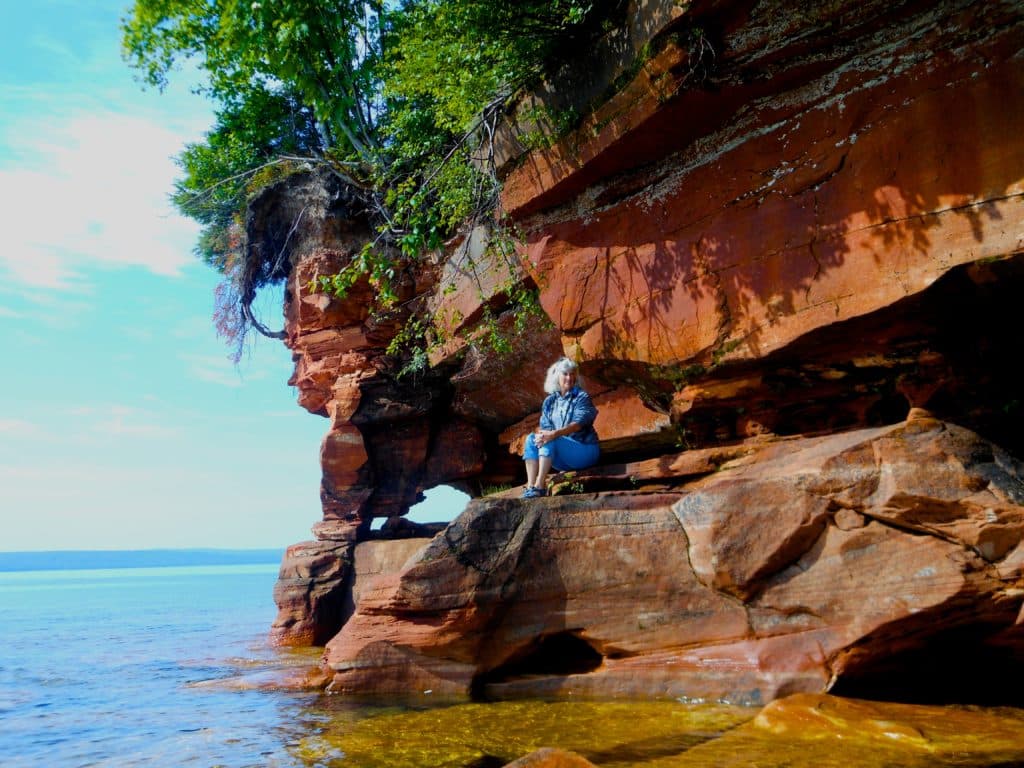
We preferred the remote and dramatic Canadian shore of Lake Superior, but the previous year we’d ended our summer in Duluth, Minnesota, at the westernmost end of the lake, and were now working our way back east. Since the Canadian shore was just barely thawed out after a very cold winter, we reluctantly decided to spend a few days back in the Apostle Islands, on the south shore. It would be warmer there, we could get last-minute chores done, and we needed to buy Leinenkugel’s beer, which is brewed in Wisconsin and one of our summer staples when we can find it.
Long home to Native Americans, the Apostles were first visited by French Jesuit priests in the 1670s; they thought there were 12 islands — hence the name — but actually there are 22. Subsequent centuries saw the islands logged, farmed, quarried, fished and finally opened to tourism. The Apostle Islands National Lakeshore was created in 1970, when the National Park Service acquired 21 of the islands and started the process of letting them revert to wilderness.
On our first day out of Duluth, we reached on lovely southwest winds for more than 50 miles and anchored in the lee of Sand Island, the westernmost in the group. A nice sunset was the perfect backdrop for cold chardonnay, guacamole, and steaks on the grill. As we crawled into bed for the night, we wondered if we had been wrong about this place. Then came the noise. The wind had suddenly swung to the northeast. The schoolchildren scraping the blackboard was our anchor chain rolling across small rubble that lay under a thin layer of sand; the thunk was Catamount fetching up hard at the end of our swing. What a crummy start in an area we hadn’t wanted to visit in the first place.
But then, slowly, the Apostles started to work their spell on us. After a few hours, the wind backed to the northwest and the seas went flat. In the morning, we launched our dinghy and explored the north end of Sand Island, where Superior’s incessant pounding had carved out sea caves in the sandstone cliffs, just big enough to row our dinghy into. We marveled at the intricately sculpted pillars and arches, the variegated colors of the stone, the ferns growing downward from the ceilings.
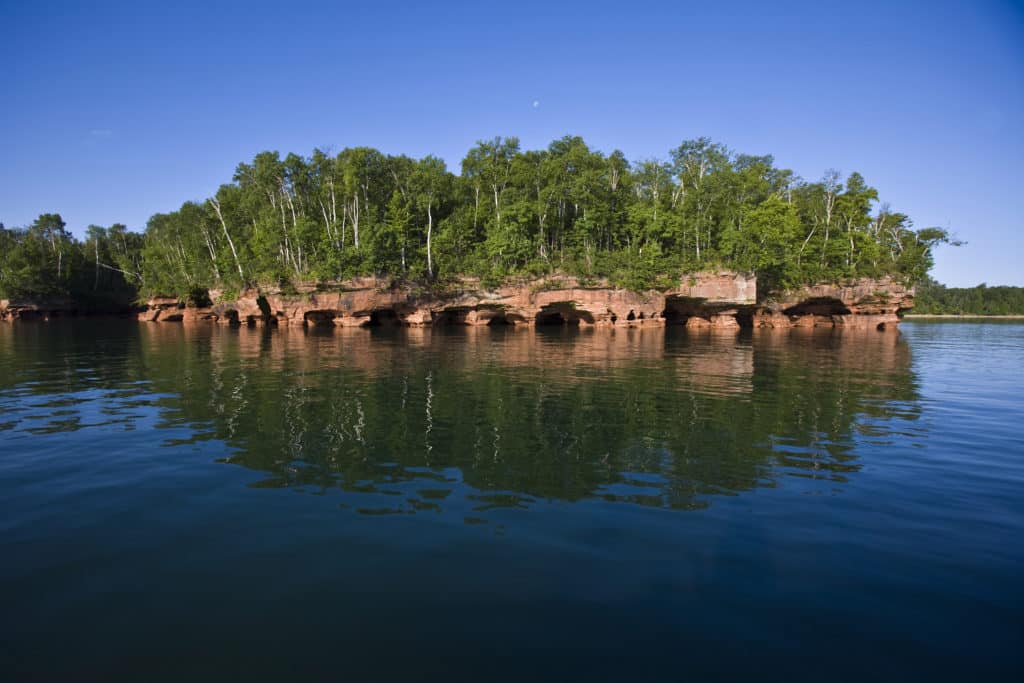
Jennifer and I sailed into the heart of the islands later that day, settling in at popular Stockton Island, where sailboats outnumbered powerboats in the anchorage by almost 10 to one. Blessedly, the Park Service has banned personal watercraft everywhere in the national lakeshore. Stockton Island has miles of white sand beaches in Quarry, Julian and Presque Isle bays. Hiking trails meander through cranberry bogs and pine forests, then break out to commanding views from open headlands. We hoped (sort of) that we would encounter one of the many black bears that inhabit every one of the islands, but we only saw tracks. In all our hikes on trails and on beaches, we never saw a single piece of trash or even any flotsam. It did indeed feel like wilderness.
Stockton Island also reminded us of what it’s like to anchor over hard, rippled sand. In our more familiar waters on the Canadian side, we never see our anchor hit bottom (the water is just too dark), and we are never sure what the anchor grips onto. In the Apostles, we could watch our anchor drop 20 feet through the gin-clear water, sploosh onto the sand, and sink its flukes to engage Mother Earth. Then we could watch the chain pay out, snub it off at 60 feet, and know that Catamount wasn’t going anywhere with that grip. We reminded ourselves that we hadn’t dragged even on the first night, when we were caught by the sudden wind shift at Sand Island.
One morning we hiked to an old quarry on Stockton. After the Great Chicago Fire of 1871, the call went out for a more durable building material, and the sandstone of the Apostles (dubbed brownstone at the time) seemed the perfect solution. Boatload after boatload of Apostle Island sandstone went down to Chicago to help rebuild the ravaged city.
We beat in light air farther east to remote Michigan Island, where the Park Service had just reopened the 1857 lighthouse after a million-dollar restoration. It’s a short walk from the dock up to the lighthouse grounds, where volunteer keepers interrupted their dinner to give us a tour. Then we huffed and puffed our way up 127 steps to the top of the “new” 1929 tower, where the Coast Guard still maintains a light. The 360-degree view was stunning.
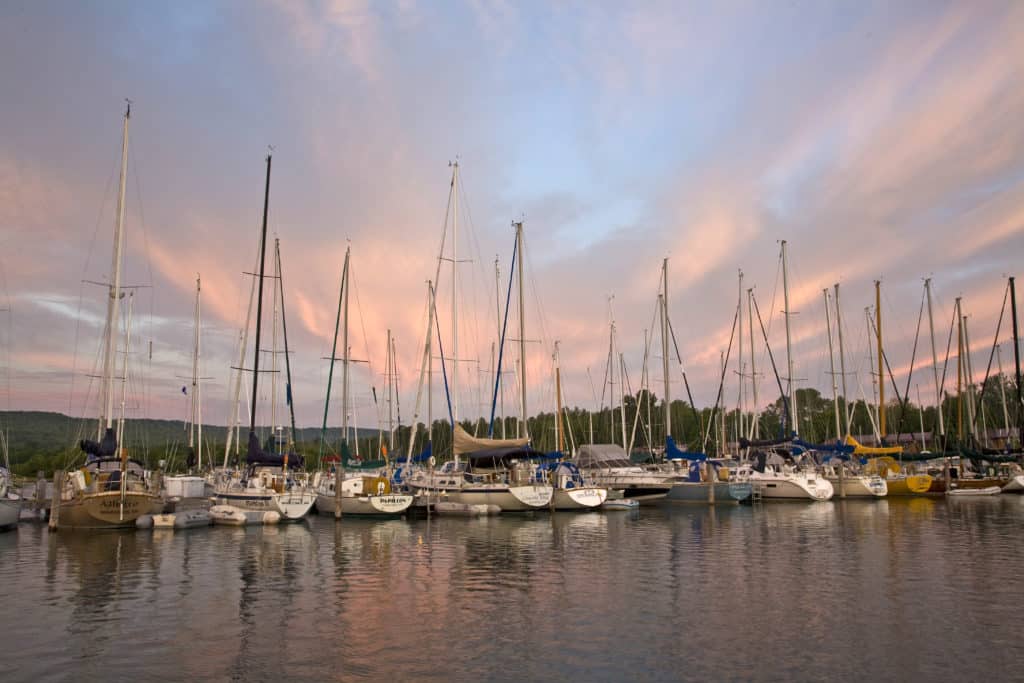
When it was time to pump Catamount’s holding tank and get more beer, it was off to Bayfield, Wisconsin, the epicenter of Apostle Island sailing and dubbed the “Best Little Village in the Midwest” by the Chicago Tribune. Bayfield is a crunchy spot with great 19th-century architecture, locally roasted coffee and Leinenkugel’s on tap. Tucked into the town marina, we were a block from the ferry terminal out to bustling Madeline Island (the only Apostle not in the national lakeshore) and within easy walking distance of supplies, including freshly caught whitefish off a fishing boat run by two local women. Locals suggested breakfast at Greunke’s, which has been hosting travelers since 1866. Its ceilings are low and plastered with Life magazine covers, and its walls are covered with memorabilia and photos dating back to the ’20s. Although I passed on the house specialty of sauteed whitefish livers, I did justice to the biscuits and gravy. The biscuits were the size of saucers and the gravy tough on my coronaries, but I am proud to say I didn’t need a doggy bag. Jennifer had oatmeal and grinned at my excess.
We discovered we had arrived at the start of the annual Bayfield Race Week. Everything from 27-foot family cruisers to a 50-foot Nelson/Marek was on the water in seven classes. The kickoff event is the Around the Islands Race, a clockwise race of about 80 miles that can take 36 hours to complete, though this year the race was shortened due to anticipated light air.
Hoping to catch some of the opening-day action, we motored out to Devil’s Island, the farthest north of the Apostles. Knowing the huge race fleet would take a while to get there, we let Catamount float on the flat waters while we rowed our dinghy the length of the island’s sea caves. Even without wind, there was enough motion in the caves to give a quiet glooping sound to add to the eeriness. The caves here lack the subtlety and grace of their smaller Sand Island cousins, but they extend for nearly a mile and are simply awe-inspiring. Watched over by an 1891 light tower, the Devil’s Island caves are the signature image of the Apostles’ storm-battered coast.
As we rounded the northwest side of the island near dusk, we saw the race fleet headed our way, but the light air had become no air. We stayed well off to the side as the boats crawled past the caves, with not a sound from any of the crews or a single motion that might upset their balance. With 50 miles still to go, it was going to be a long night for the racers. Conditions improved, though, and three days later, on a different 12-mile windward/leeward course, we saw the same boats flying spinnakers in 20 knots of wind on a madcap dash to the finish line off downtown Bayfield.
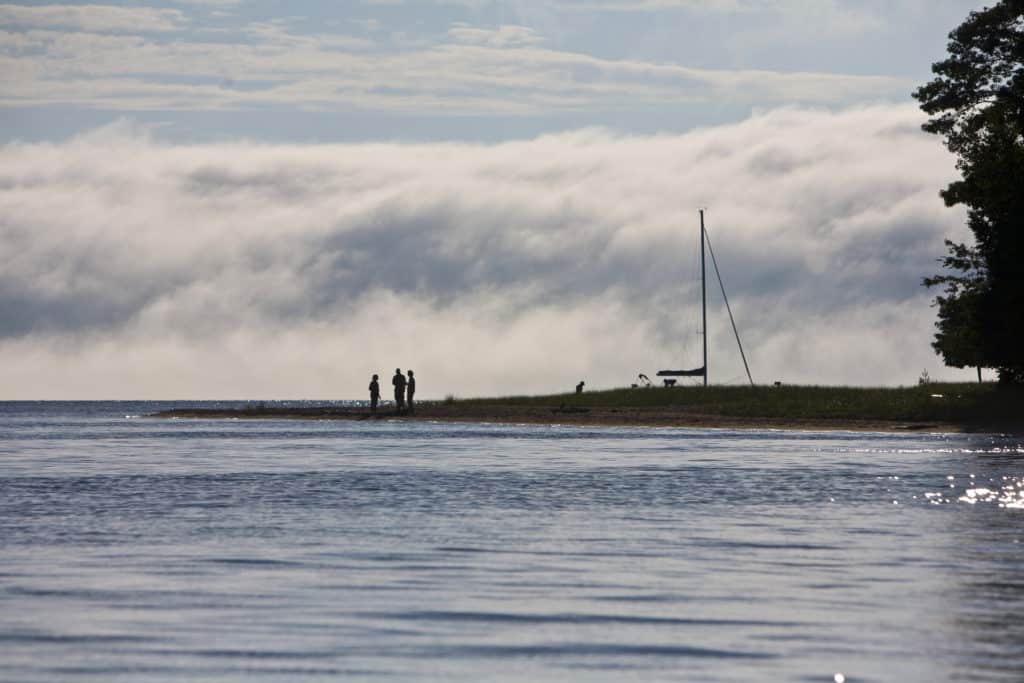
For two nights we settled on the north side of Oak Island, where we hiked up its 200-foot-high sand bluff to look out over the islands and the open lake. Several of the outer islands slowly dissolved into a fog bank, and we almost needed radar on the dinghy to find Catamount when we rowed back. But as the wind pushed the fog to the east, we were surrounded in the cockpit by our own personal rainbow — a “fogbow,” if you like — that started on our bow and ended on our stern.
Lake Superior’s average summer water temperature is a killer 49 degrees, but at Oak Island we swam off the boat in June. Local mariners assured us that by August the water is downright toasty. No way that ever happens on the Canadian shore.
It’s clear why sailboats rule here. Sailors can haul anchor, set out for the day, be fairly assured of good winds, sail to their heart’s content, and use their dinghy-racing skills to tack and jibe and kite their way through all the narrow channels. Underwater obstructions are rare, and what is there is almost always sand. Then, at the end of the day, they can check the forecast, call their buddies, and pick an anchorage that (usually) works for the night.
OK, full disclosure here: We did have to move once in the middle of the night. While we were parked on the east side of Raspberry Island, after a visit to its 1863 lighthouse and a chat with the very knowledgeable park ranger, the wind veered straight down on us well after dark. So we had to raise anchor and work our way back to Stockton Island’s Quarry Bay. But you know what? The moon was full, it was warm, we were by ourselves, and there was nothing to hit.
We also discovered one other advantage to anchoring in the Apostles. Because there are no hidey-holes and no fully protected harbors, every anchorage has a view, whether it’s of the sunset, the sunrise, the next wilderness island or out onto the vast expanse of Lake Superior itself.
We had planned to stay in the Apostles only a few days before heading for Canada; we wound up staying nearly two weeks. Occasional anchoring issues now seem trivial. We were impressed by the sailing opportunities: good winds, great views, attractive little Bayfield, historic lighthouses, sea caves and hundreds of like-minded sailors, all in a wilderness setting. We had clearly been wrong the first time. Aside from that first night with the blackboard-scraping schoolchildren, we loved every minute of our visit.
So mea culpa, Apostle Islands. You deserve all those accolades.
Fred and Jennifer Bagley live in Vermont and sail Catamount on the Great Lakes every summer.



